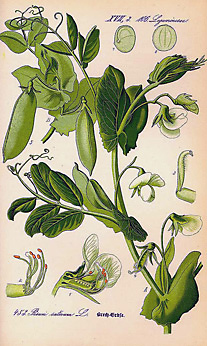Peas, Please
By Audrey Stallsmith

Pease porridge hot, pease porridge cold,
Pease porridge in the pot, nine days old;
Some like it hot, some like it cold,
Some like it in the pot, nine days old.
--Medieval Nursery Rhyme
I’m pleased with myself for actually getting my peas sown on time this year, which means about six weeks earlier than warm weather crops. Whether I planted enough remains to be seen, since I placed them closely together in an outer corner of the garden, where the neighbor who tills it later should be able to avoid them easily.
Native to Asia and the Middle East, peas have been around about as long as people have, though the original varieties were starchy field types as hard as the similar dried beans and varying in color from gray and blue through brown and white. Hard enough that religious pilgrims used to place them in their shoes as a kind of penance. Hard enough that a sensitive princess supposedly could feel one through a stack of mattresses!
The more succulent “garden peas” (Pisum sativum)—their species name meaning “cultivated”—didn’t turn up until the 17th century, and our current version may have originated with British botanist Thomas Knight in the early 19th century. That could be why they sometimes also are called “English peas.”
Many children don’t like them and consume them only under protest. As Lord Chesterfield once said, “Being pretty on the inside means you don’t hit your brother and you eat all your peas. That’s what my grandma taught me.”
But we kids would beg for peas when I was young, since we were familiar with the fresh from the garden rather than the mushy canned type. We even would chew on the pods back before snap (Pisum sativum var. macrocarpon) and snow peas (Pisum sativum var. saccharatum) became a “thing,” simply because those pods also tasted sweetly succulent.
Of course, they retain that moisture through being picked while still “young.” Split peas, on the other hand, mature completely before being dried, skinned, and broken apart at their natural seams. They generally are grown from more smooth-skinned and less sweet cultivars than garden peas are. In England, the traditional pease porridge usually contains yellow split peas, though we Yanks opt for green ones in our split pea soup.
Keep in mind that some peas, such as the black-eyed type, actually are beans rather than peas, since they derive from the Vigna rather than the Pisum genus. And, yes, your mother was right that peas are good for you, since they are high in Vitamins A and C, as well as folate, thiamin, iron, phosphorus, protein and the fiber which can help prevent appendicitis.
Recent research also indicates that, due to a resistant starch, peas also potentially could help control blood sugar spikes, and their protease inhibitors decrease inflammation. However, you may want to avoid peas if you are trying to conceive, since they reportedly reduce fertility in both men and women.
Peas often are cooked with mint, perhaps a way of heading off the indigestion potentially caused by the consumption of any legumes. We like to simmer fresh peas in a cream sauce with new potatoes, for a flavor that would “appease” even the most critical palate!
Similar in appearance to sweet peas, garden pea plants look lovely even before they bear fruit, so somebody really should write a poem about them. Preferably something more lyrical than the following anonymous verse that my dad likes to quote! “I eat my peas with honey; I’ve done it all my life. It makes the peas taste funny, but it keeps them on the knife.”
Image: The Pisum sativum image is by O.W Thomé, from Flora von Deutschland Österreich und der Schweiz, courtesy of plantillustrations.org.








